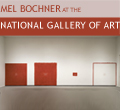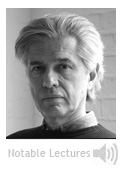
 Theory of Boundaries (1969–1970) by Mel Bochner is an important early work of conceptual art. In this piece, one can see an example of the transition that began to take place, during the 1960s, from abstract painting and minimal sculpture, to idea-based works using language as an organizing principle. Like the abstract paintings of Frank Stella and Robert Ryman, Theory of Boundaries demonstrates an interest in the physical and mechanical processes that are involved in the act of painting. Building on the investment in process, systems, and structures evident in minimal painting and sculpture, Theory of Boundaries makes explicit the formal criteria governing the appearance of the work. In other words, the work itself uses language to state the formal logic determining the relationships between the colored surface, the border, and quality of enclosure in each of the work's four squares. These relationships are presented in the form of what Bochner calls a "language fraction."
Theory of Boundaries (1969–1970) by Mel Bochner is an important early work of conceptual art. In this piece, one can see an example of the transition that began to take place, during the 1960s, from abstract painting and minimal sculpture, to idea-based works using language as an organizing principle. Like the abstract paintings of Frank Stella and Robert Ryman, Theory of Boundaries demonstrates an interest in the physical and mechanical processes that are involved in the act of painting. Building on the investment in process, systems, and structures evident in minimal painting and sculpture, Theory of Boundaries makes explicit the formal criteria governing the appearance of the work. In other words, the work itself uses language to state the formal logic determining the relationships between the colored surface, the border, and quality of enclosure in each of the work's four squares. These relationships are presented in the form of what Bochner calls a "language fraction."
According to the artist's explanation in a note-card study for the work: "The first term of the language fraction refers to the tangential relationship of the film—color in this case—and the border. The second term refers to its position (the film) as regards the sense of enclosure (enclosure considered as condition of position)." Using Bochner's explanation, one can therefore see that in the far left square of the work the boundary of the color surface is at the border and in the enclosure; in the second square the boundary of the color surface is over the border and in the enclosure; in the third square the boundary of the color surface has no relationship to the border (this is why the first term of the fraction is empty) and is in the enclosure; and in the last square the boundary is at the border but out of the enclosure. Theory of Boundaries is in this way both a statement about the underlying formal principles of painting, and painting itself.
On view in the National Gallery's East Building, Concourse Gallery 29F.



